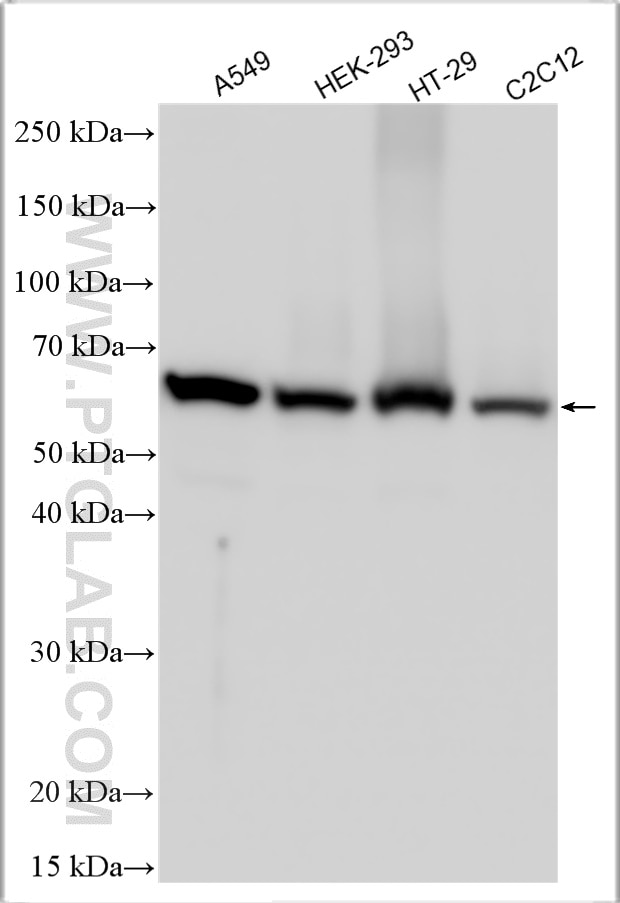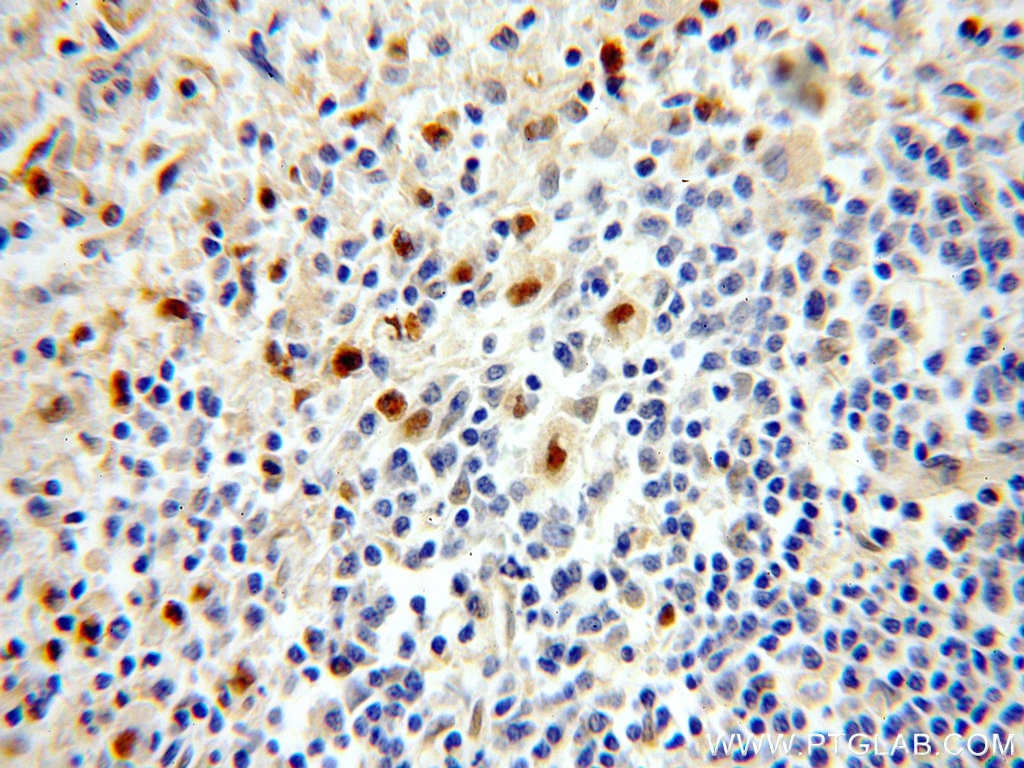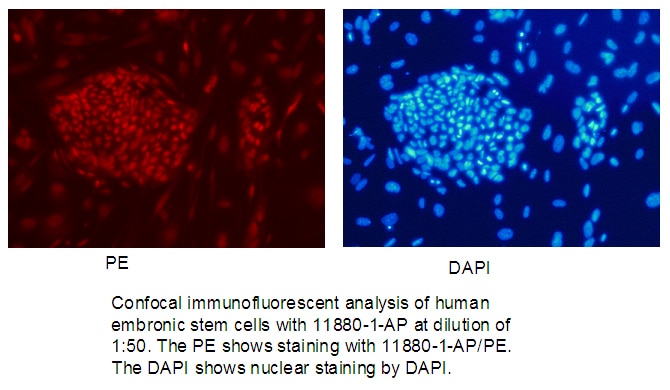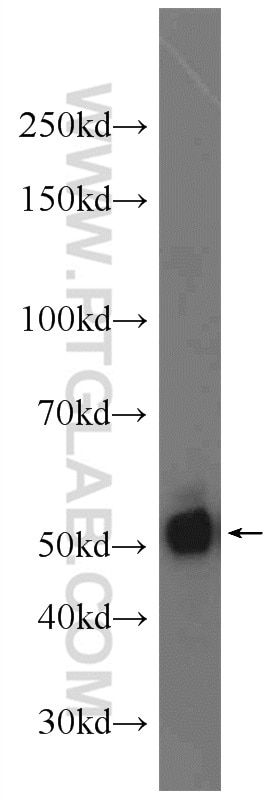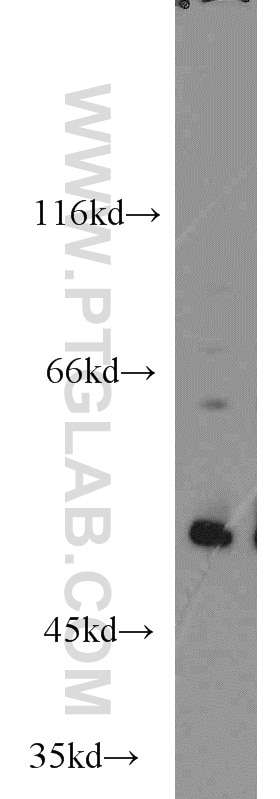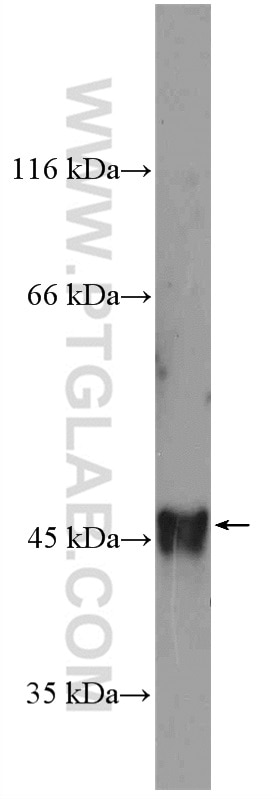- Phare
- Validé par KD/KO
Anticorps Polyclonal de lapin anti-KLF4
KLF4 Polyclonal Antibody for WB, IHC, FC (Intra), IP, ELISA, IF
Hôte / Isotype
Lapin / IgG
Réactivité testée
Humain, rat, souris
Applications
WB, IHC, IF/ICC, FC (Intra), IP, ChIP, ELISA
Conjugaison
Non conjugué
123
N° de cat : 11880-1-AP
Synonymes
Galerie de données de validation
Applications testées
| Résultats positifs en WB | cellules A431, cellules A549, cellules C2C12, cellules HEK-293, cellules HeLa, cellules HT-1080, cellules HT-29, cellules HUVEC, cellules NCCIT, tissu hépatique de souris, tissu pulmonaire de souris |
| Résultats positifs en IP | cellules HeLa, |
| Résultats positifs en IHC | tissu embryonnaire de souris, tissu amygdalien humain, tissu de côlon humain, tissu splénique humain il est suggéré de démasquer l'antigène avec un tampon de TE buffer pH 9.0; (*) À défaut, 'le démasquage de l'antigène peut être 'effectué avec un tampon citrate pH 6,0. |
| Résultats positifs en IF/ICC | cellules souches embryonnaires humaines |
| Résultats positifs en FC (Intra) | cellules HeLa, |
Dilution recommandée
| Application | Dilution |
|---|---|
| Western Blot (WB) | WB : 1:1000-1:8000 |
| Immunoprécipitation (IP) | IP : 0.5-4.0 ug for 1.0-3.0 mg of total protein lysate |
| Immunohistochimie (IHC) | IHC : 1:50-1:500 |
| Immunofluorescence (IF)/ICC | IF/ICC : 1:20-1:200 |
| Flow Cytometry (FC) (INTRA) | FC (INTRA) : 0.40 ug per 10^6 cells in a 100 µl suspension |
| It is recommended that this reagent should be titrated in each testing system to obtain optimal results. | |
| Sample-dependent, check data in validation data gallery | |
Informations sur le produit
11880-1-AP cible KLF4 dans les applications de WB, IHC, IF/ICC, FC (Intra), IP, ChIP, ELISA et montre une réactivité avec des échantillons Humain, rat, souris
| Réactivité | Humain, rat, souris |
| Réactivité citée | rat, Humain, souris |
| Hôte / Isotype | Lapin / IgG |
| Clonalité | Polyclonal |
| Type | Anticorps |
| Immunogène | KLF4 Protéine recombinante Ag2480 |
| Nom complet | Kruppel-like factor 4 (gut) |
| Masse moléculaire calculée | 504 aa, 54 kDa |
| Poids moléculaire observé | 50-60 kDa |
| Numéro d’acquisition GenBank | BC030811 |
| Symbole du gène | KLF4 |
| Identification du gène (NCBI) | 9314 |
| Conjugaison | Non conjugué |
| Forme | Liquide |
| Méthode de purification | Purification par affinité contre l'antigène |
| Tampon de stockage | PBS avec azoture de sodium à 0,02 % et glycérol à 50 % pH 7,3 |
| Conditions de stockage | Stocker à -20°C. Stable pendant un an après l'expédition. L'aliquotage n'est pas nécessaire pour le stockage à -20oC Les 20ul contiennent 0,1% de BSA. |
Informations générales
The mammalian Krüppel-like transcription factor 4 (Klf4) is an evolutionarily conserved zinc finger-containing transcription factor with diverse regulatory functions in cell growth, proliferation, differentiation and embryogenesis. It also plays a significant role in the process of tumorigenesis. Klf4 is one of the key transcription factors that have been used to reprogram mouse and human fibroblasts to a pluripotent state also called induced pluripotent stem (iPS) cells. Affinity purified rabbit anti- Klf4 is for the detection of Klf4 transgene expression in the process of reprogramming. There are two isoforms of KLF4 (PMID: 15561714), with MW range from 50 to 60 kDa,and major band is 55 kDa. KLF4 protein can be ubiquitin modified.
Protocole
| Product Specific Protocols | |
|---|---|
| WB protocol for KLF4 antibody 11880-1-AP | Download protocol |
| IHC protocol for KLF4 antibody 11880-1-AP | Download protocol |
| IP protocol for KLF4 antibody 11880-1-AP | Download protocol |
| FC protocol for KLF4 antibody 11880-1-AP | Download protocol |
| Standard Protocols | |
|---|---|
| Click here to view our Standard Protocols |
Publications
| Species | Application | Title |
|---|---|---|
Nat Commun Klf4 glutamylation is required for cell reprogramming and early embryonic development in mice. | ||
Nat Commun LncBRM initiates YAP1 signalling activation to drive self-renewal of liver cancer stem cells. | ||
J Hematol Oncol A novel lncRNA ROPM-mediated lipid metabolism governs breast cancer stem cell properties. | ||
Mater Today Bio Cellular reprogramming with multigene activation by the delivery of CRISPR/dCas9 ribonucleoproteins via magnetic peptide-imprinted chitosan nanoparticles. | ||
EMBO J Fatty acid synthesis is critical for stem cell pluripotency via promoting mitochondrial fission. | ||
J Neuroinflammation The critical role of KLF4 in regulating the activation of A1/A2 reactive astrocytes following ischemic stroke |




